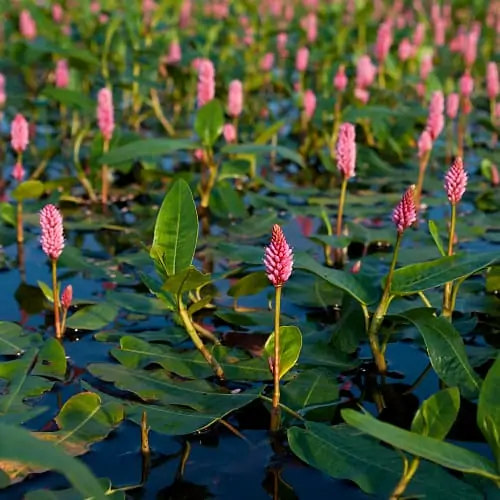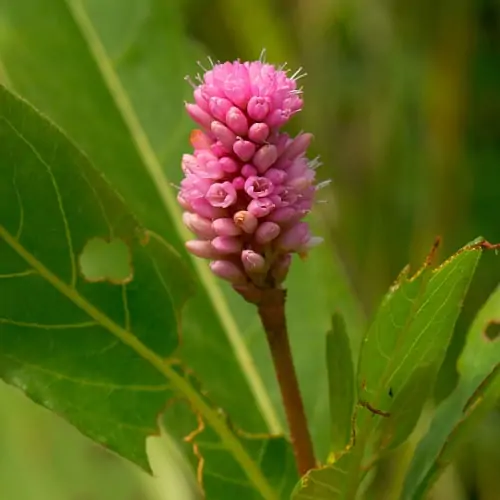
Also known as water smartweed and several other common names, including long root smartweed, water knotweed, water smartweed, and amphibious bistort, Persicaria amphibia (previously known as Polygonum amphibium) is a species of flowering plant in the knotweed family (Polygonaceae). It is native to much of North America, Asia, Europe, and parts of Africa, and it grows elsewhere as an introduced species (Mexico, South America, and southern Africa). When overgrown it is often considered a noxious weed.
The meaning of the species name comes from the Latin words “persicaria” meaning ‘peach-like’, derived from persica for ‘peach’, and aria, meaning ‘pertaining to’. The name is referring to the leaves being similar to those of peaches, while “amphibia” refers to its ability to grow in water or on land.
In terrestrial form, it is 1 to 3 feet tall, more or less erect and either branched or sparingly branched. In aquatic form, stems of the plant are 6 feet long and the upper leaves float on the water surface. Its flowers are 4 – 6 mm long and each flower contains 5 pink to rosy pink sepals.
So, what makes water smartweed a unique plant? Since it has both a terrestrial and aquatic form it can survive variable conditions; especially in areas that suffer a lot of flooding.
Primarily it is considered to be a wetland plant but water smartweed can also be found in lakes, ponds, canals, slow-flowing rivers, and ditches. In its terrestrial form, it can be found in damp places like watersides, marshes, wet meadows, and dune-slacks, as well as a weed on cultivated land. Human activity has dispersed it to road verges, railway banks, allotments, grassland, arable fields, spoil heaps, and waste tips. Maritime habitats include shingle beaches, calcareous lochs, and brackish estuaries.
Water Smartweed Growth, Hardiness & Climate

It usually grows to be up to 1 to 3 feet tall in its terrestrial form, but stems can be up to 6 feet long in aquatic form, usually growing semi-submerged. It flowers from mid-summer into autumn in bright reddish to pink flowers which are 1-10 cm long. Places for growth vary in regards to where you need the plant. It is usually found in full sun. Soil acidity should be between 3.0 and 8.0 on the pH scale.
How to Plant Water Smartweed

Propagation is done by seeds, roots, and trailing stems. Vegetative reproduction is very effective by the spread of stems and rhizomes, disseminated by human activity, wave action, water‐currents, or by birds and large mammals during grazing. A single 2‐cm section containing a node can start a new colony. It can also be seed-sowed in a cold frame during spring. When the plants are large enough to handle, they can be planted.
How to Care For Water Smartweed

Water smartweed grows best with full sunlight or light shade, in relatively nutrient‐rich water or well‐irrigated deep soil. Planting should be restricted to flat sites or slopes positioned less than 20°. It grows in sand, clay, loam, peat, shingle, manure, underwater silt, and black mud. As already mentioned, soil pH should be between 3.0 and 8.0, with the ideal pH being approx. > 4.5. When exposed to flooding, the plant assumes an aquatic form.
Water smartweed grows in still water or in streams and rivers with a slow to moderate flow, and can tolerate seasonal spates, but not vigorous wave action in large lakes. The floating form, found at water depths of 30–200 cm, is tolerant of turbidity caused by sediment or algae, mesotrophic or eutrophic conditions, and brackish saline water. However, high salinity for an extended time is fatal to the plant.
Regular and high rainfalls are beneficial and propagate growth. In a prolonged summer drought, the plant becomes xeromorphic and fails to flower. A persistently windy situation can have the same effect in spite of adequate soil hydration. It tends to be absent from very eutrophic or limy waters.
How to Winter Water Smartweed
Water smartweed is very sensitive to frost. It is often the first plant to die in autumn, and early growth may be killed by late spring frosts. When the water does not freeze solid and there is air beneath the ice, aquatic colonies may retain some stems above the sediment, unlike the terrestrial form which almost invariably dies back to below ground level in winter.
Terrestrial plants growing near industrial warm water can survive a mild winter. Seeds survive winter only in damp and cool conditions.
Is Water Smartweed Invasive or Toxic?
Although the species is native to most of Eurasia, it is often regarded as a ‘mischievous weed’ and difficult to control as it persists due to a high tolerance of pollution and increasing eutrophication. It is usually removed physically by cutting, or the roots can be dug up. However, physical control is difficult because it can re-establish itself from seeds and remaining roots.
At this time, there are no known biological control methods for water smartweed. Goats are known to forage on many types of emergent vegetation. A more potent option is to use herbicides, but that comes with a health risk. Glyphosate is the only known chemical agent that has been proven to achieve long‐term elimination. It is resistant to dalapon and terbutryn, and only temporarily suppressed by dichlorbenil, chlorthiamid, and diquat.
Water smartweed is a good accumulator of inorganic elements such as phosphorous and nitrogen, as well as some other toxic metals (Fe, Pb, Cd, Cu, Mn, Hg, As). It is for this reason that it was suggested the plant could be used as a bioassay of useful minerals or to clean up badly polluted sites. In addition to this, water smartweed has antibacterial and antifungal properties, and is a powerful antioxidant.
Where to Buy Water Smartweed & Seeds? (UK & US)
The plant can be commercially obtained in most of North America, except Florida. It should be readily available to purchase in the UK and Europe from many online nurseries.


Hello and thank you for this detailed summary of water smartweed. I was looking for info on how to propagate it and you provide that. I just have a comment about your use of the term, species. Persicaria is actually the genus name and amphibia the species name. Because you called Persicaria the species, I am uncertain about what you are referring to later on when you say the species is Eurasian and a noxious weed. Are you still talking about the species or the genus?